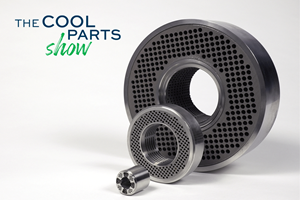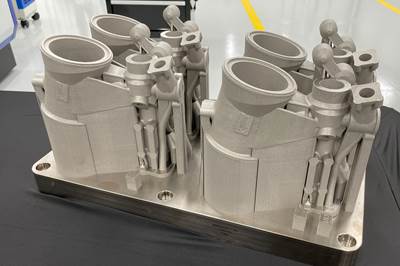
Two laser powder bed fusion machines each equipped with 12 lasers will be the heart of additive manufacturing for aircraft engine part production at Collins Aerospace's West Des Moines facility.

In this photo and the next, samples of the kinds of parts likely to be made through AM on the new machines.
On the campus of the Collins Aerospace production site in West Des Moines, Iowa, one room — one very large, newly added room — contains the resources able to replace (or nearly replace) an entire supply chain.
Today, turbine components featuring intricate internal geometries, such as fuel nozzles, are produced through a series of steps including casting or forging followed by machining, brazing and more machining. Some of the work is performed by suppliers and much of it is performed here in the Collins plant, but the work in general is spread across various groups and stations covering a broad floorspace or geographic footprint.

Parts in this photo and the previous one are all for land-based turbines. Parts for aircraft turbine engines will be similar.
But in the future, certain components for aircraft turbine engines will be made through additive manufacturing — specifically laser powder bed fusion (LPBF) — in a new addition dedicated to this purpose. I paid a visit to West Des Moines to see this new facility and understand its role.
The extent of the AM production capacity now in operation here is notable. The heart of the new production system for 3D printed aircraft components is two 12-laser NXG XII 600 machines from Nikon SLM Solutions. Collins, one of the earliest users of the 12-laser system, has one of the machines dedicated to nickel-based alloy and the other to aluminum alloy. With a build volume of 600 mm cubed, each machine will produce parts in batches at a time, and with 12 lasers working simultaneously, cycle times will be relatively fast. Other equipment in the same room as these machines addresses depowdering (technically in its in own area, but closely adjacent) as well as cleaning, heat treatment and electrical discharge machining (EDM) for part cutoff. Only hot isostatic pressing (HIP) or finish machining involves steps outside this new addition.

Slater Johansen (left) leads me through the new AM facility. Postprocessing resources visible behind us include a heat treating furnace and an EDM machine for cutoff. All of this is in the same large room as the new 12-laser machines. (Part cleaning, not visible in this photo, can be seen to the left in the banner image at the top of the page.)
One of the hosts for my visit was Slater Johansen, additive manufacturing leader for the facility. At one point, he motioned to the powder racks. Unopened canisters of metal powder waited on shelves near the AM machines. “That is our inventory,” he said.
I nodded. I thought I knew what he meant. That is their raw material inventory.
But no. His meaning dawned on me a moment later. That powder is also their work-in-process inventory. Additive manufacturing via a facility like this one allows for radical vertical integration and radical consolidation of production steps. Part of the cost savings is found in the capital liberated from having fewer incomplete parts in work at any moment throughout the plant or throughout the process chain — a cost so fundamental to production that it often goes unconsidered. With AM, components will not queue at interim stations or travel long distances via pallet and truck. Rather, work will flow from powder to completed part in a short span of time across a short physical distance.

Additive manufacturing allows parts with intricate internal features, currently built through joining via brazing, to be produced more quickly and reliably by 3D printing them in one solid piece.
The result is a very different picture of the way certain, select aircraft engine parts will be made in the future. For Collins, though, the picture is not new. The company has made land-based turbine components in a similar way for years, using smaller, single-laser AM machines here in West Des Moines. But land-based turbine components are produced in lower volumes. The new addition for the new, larger 12-laser machines came when Collins Aerospace’s customers made clear to the company that they aimed to shift future aircraft parts to additive manufacturing as well.
For these aircraft makers, the lead time savings of a more consolidated process is one of the chief arguments for this shift. But the cost savings come from more than just the time reduction, Collins notes. Part of the consolidation in making turbine components additively involves replacing what used to be subassemblies with solid parts. Assembly steps are eliminated, and in nozzle components in particular, that assembly is challenging. Applying brazing to join these parts in a way that ensures accurate, intricate internal passages is a high-skill operation that is prone to scrap — to such an extent that 50% production yield is accepted for these parts. With the additive process, by contrast, the rate of acceptable parts will be above 90%. Simply put, with AM, a much larger proportion of manufactured parts will make it onto planes.

Turbine fuel nozzles such as the one seen here are a leading example of a type of component with intricate, precise passages relying on brazing today that can be made free of brazing through AM.
Lead Time and Assembly Reduction via AM
Turbine engine fuel delivery nozzles are a core strength of the West Des Moines production site, which employs about 450 across multiple facilities here. Collins Aerospace more broadly is a supplier to aerospace and defense industries with more than 300 locations globally. (We have reported on one other location: the AM facility opened in 2022 in Monroe, North Carolina to serve metal additive manufacturing needs across Collins Aerospace). Operations performed in West Des Moines include brazing, machining, LPBF and inspection. Parts produced here, in addition to nozzles, include impellers, housing components and ducting.
For land-based turbines — meaning turbines used for power generation rather than aircraft flight — parts have been made via AM since 2017 on single-laser LPBF machines from DMG MORI. On some nozzle designs made this way, 3D printing has allowed what used to be 20 parts to be replaced with four or five, according to Jake Krohn, senior additive business manager with the company. Collins’ process includes optical scanning plus computed tomography (CT) for inspection of complex AM parts that eliminate assembly steps.
“We produce one solid piece that used to be an assembly,” he says, “and all that’s needed is to braze on a fitting.”
Further, he says, designing this way allows for considerable latitude in optimizing for the characteristics of the part important to the customer. A component demanding skilled, critical, manual joining does not offer this freedom to the same extent.
“We can balance cost, quality, schedule, weight — and throttle for what is important,” he says. Now, the same freedom will apply to aircraft engine components.
The precise nature of the aircraft parts to be produced on the 12-laser machines is information the Collins team wishes to protect. Aircraft-industry work is more sensitive than power generation work. All the photos in this article show land-based turbine components. However, the imagination does not have to leap far — turbines on the ground and turbines in the air are similar in design and fundamentally the same in operation.

The new additive manufacturing capability is located in a new addition, seen at right.

Ceiling height is one of the reasons a new addition was needed. On the new AM machines, the hopper containing metal powder is delivered to the top of the machine.
Lead times are not the only reason for the aircraft-industry interest, but a major factor. The lead times for some castings necessary for aircraft engine parts have stretched to 52 weeks, Johansen says. Meanwhile, the complete process for parts made additively — from powder to completed part — takes no more than 8 weeks, and that is when HIP (the most time-consuming factor) is needed. The 3D printing cycle itself requires just a couple days on the 12-laser machines.
The Path to AM Production for Aircraft Parts
While aircraft turbine engines are operationally similar to their land-based kin, the criticality is very different. The new parts to be made in the new addition for Collins are subject to more demanding validation and regulatory requirements. This affects the way forward.
The new capacity entails some new staff positions. Sixteen people staff the additive center, including engineering, quality, production, maintenance and operation. The interaction of this staffing with the production capability looks different from established production. The AM process is largely unattended, such that the new room is often empty of people.
But the course to full production utilization of this new capacity will entail a necessary wait. The criticality of parts to be made here is a result of the fact that these parts (unlike land-based turbines) must fly and must carry people. Aircraft OEMs and the Federal Aviation Administration are therefore involved in the effort to validate and approve the process in this facility and the parts it makes. At present, there is one production part apiece being developed on each of the new AM machines.
Given the extent of the validation requirements, getting the process for these parts approved will likely take until the end of 2025, Krohn says. For the aircraft industry, he notes, that is not really a long wait.
And a payoff will come after that, he says, because much of the work of validating the process for these parts will apply to future parts on the same machines, and will not have to be performed again. After 2025, future additive parts at Collins will advance into production much faster.
Related Content
This Year I Have Seen a Lot of AM for the Military — What Is Going On?
Audience members have similar questions. What is the Department of Defense’s interest in making hardware via 3D printing over conventional methods? Here are three manufacturing concerns that are particular to the military.
Read MoreHow Machining Makes AM Successful for Innovative 3D Manufacturing
Connections between metal 3D printing and CNC machining serve the Indiana manufacturer in many ways. One connection is customer conversations that resemble a machining job shop. Here is a look at a small company that has advanced quickly to become a thriving additive manufacturing part producer.
Read MoreVariable Resistance Valve Trim Achieves Lead Time Reduction Through AM: The Cool Parts Show #69
Baker Hughes is realizing shorter lead times and simplified manufacturing through powder bed fusion to produce valve trims previously assembled from many machined metal parts.
Read MoreBig Metal Additive: The Difference Between a Shape and a Part Is Quality
Preparing to scale directed energy deposition to ongoing full production is not a technological challenge: DED is ready. But it is an organizational challenge, says the company founder. Here is what it means to implement a quality system.
Read MoreRead Next
Why AM Leads to Internal Production for Collins Aerospace (Includes Video)
A new Charlotte-area center will provide additive manufacturing expertise and production capacity for Collins business units based across the country, allowing the company to guard proprietary design and process details that are often part of AM.
Read MoreVideo Tour: Collins Aerospace AM Production Site in West Des Moines
The 12-laser powder bed fusion machines are at the heart of the company’s new production capacity for aircraft engine parts in both aluminum and nickel-based alloy.
Read MoreAlquist 3D Looks Toward a Carbon-Sequestering Future with 3D Printed Infrastructure
The Colorado startup aims to reduce the carbon footprint of new buildings, homes and city infrastructure with robotic 3D printing and a specialized geopolymer material.
Read More






















